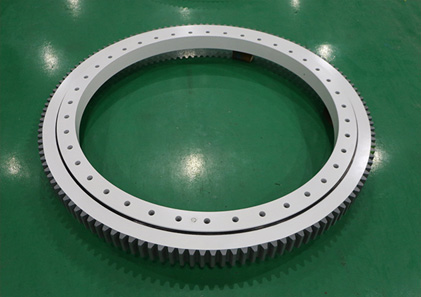Causes and Preventive Measures of Quenching Soft Spots of Slewing Bearings
In the production process of the slewing bearing, the hardness of the steel ring is locally lower after the quenching process, which usually occurs after the quenching. This situation is called the quenching soft point, and when the pieces appear, it is called the quenching soft belt. The location where the soft spot occurs is that the bearing has low hardness, which will affect the quality of subsequent grinding. Fatigue damage is also prone to occur during use, which affects the service life of the bearing. So what is the reason for the quenched soft spot of the slewing ring?
Reasons for the soft spot of slewing bearing quenching
1. Decarburization: When the metal is heated in the furnace or the atmosphere in the furnace is not good, it is easy to cause decarburization. The process of decarburization is that the carbon element in the bearing steel reacts with clear or oxygen at high temperature to generate methane or carbon monoxide. This situation will reduce the surface carbon content and the hardness to meet the requirements.
2. Insufficient temperature: Insufficient heating temperature and insufficient heat preservation make the bearing material matrix not fully austenitized. After quenching, it cannot completely transform into martensite, resulting in local soft spots. In addition, the local cooling rate is too low, the bearing surface has bubbles or contaminants, or the critical cooling rate is not reached in the close contact of the workpiece, and it cannot all become martensitic.

3. Uneven steel structure: If the original structure of the workpiece material used in the production of the bearing is not uniform, such as carbide segregation, carbide aggregation, etc., it will affect the quenching effect of the bearing.
4. Inductor problem: The structure of the inductor and the positioning fixture during quenching are not good, which affects the heating effect, or the center line of the spray cooling hole on the inductor and the quenched surface are perpendicular or angled improperly, resulting in uneven heating, heating, and cooling. The situation arises. In addition, the unequal spacing between the bearing and the inductor can also cause uneven heating.
5. Poor hardenability: The material of the slewing bearing is made of steel with poor hardenability, such as carbon steel. However, if the cross section of the workpiece is large or the thickness difference is large, soft spots may appear at the large cross section.
6. Poor quenching medium: the cooling rate of the quenching medium is low or too old will cause soft spots in the bearing.
After understanding the reasons for the soft spots or soft bands of the slewing bearing, the method to improve the existing soft spots can be through annealing, normalizing, and high temperature tempering, followed by re-quenching according to the normal process, or re-quenching after recarburizing. Or, after quenching, the hardness can be improved by cold treatment, and then tempering treatment will try to solve it. So how do we avoid the recurrence of quenched soft spots in the subsequent bearing production and processing process?

Measures to prevent the occurrence of soft belts on slewing bearings
1. Reasonable material selection: pre-homogenize the defective steel before quenching to remove the problems of carbide segregation and aggregation.
2. Control the heating temperature and time: For insufficient austenitization due to insufficient heating temperature and time, we need to select the appropriate heating temperature, heating time, and holding time for the steam during processing.
3. Reasonable selection of quenching medium: strengthen the relative movement between the workpiece and the medium, or stir the medium to keep the quenching medium clean. Quenching of carbon steel in salt water can effectively prevent the generation of soft spots.
4. Strictly follow the process: perform the quenching operation correctly, correctly control the pre-cooling time, the residence time in water or brine during quenching, the residence time in water or brine during dual-medium quenching, and the residence time of graded quenching.
The above is the reason for the soft spot of slewing bearing quenched by Lunda editor and the measures to prevent the soft band. I hope it can be helpful to everyone. The soft spots of the bearing have an impact on the later grinding process and performance of the bearing. I hope everyone will pay attention to it.


